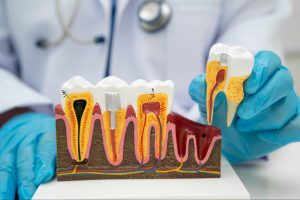People often think there’s a difference between a dental cap and a dental crown, but they’re the same thing. Dentists use the term “crown,” while many patients, especially older ones, still say “cap.” The common mix-up can lead to confusion during appointments or online research. Both terms refer to the same type of dental restoration used to cover and protect a damaged tooth. Clear language helps make decisions easier when fixing or restoring teeth.
Clarifying the Terms: Dental Cap vs. Dental Crown
Some people think dental caps and crowns are separate treatments, but they refer to the same thing. Dentists use “crown” in professional settings, while “cap” is used in casual conversations. This difference in language causes mixed signals during appointments and online searches.
“Cap” Sounds More Familiar Than “Crown”
Many grew up hearing “cap” at home or during dental visits. That term stuck because it’s easier to say and sounds less technical. Dental professionals often listen to it during casual conversations. Patients tend to feel more comfortable using words they already know.
“Cap” Feels Less Serious Than “Crown”
The word “cap” suggests a more straightforward process, like a cover on top. Some assume it’s less invasive or only cosmetic, which leads to the impression that crowns involve a deeper or more complicated process.
Ads and Media Use Both Terms Interchangeably
TV shows, social media, and dental ads throw both terms around without explaining the difference. People who see this think caps and crowns serve separate functions. The switch in wording adds more confusion instead of helping people understand. Clear info usually takes a back seat in marketing language.
People Think Caps Are Temporary
Some assume a cap is only used until a real crown is placed. This idea comes from hearing “temporary cap” during certain treatments. It seems like the cap is a short-term fix, and the crown is the final step. In reality, both terms can refer to permanent restorations.
What is a Dental Crown, and What Does it Do?
A dental crown is a custom-made restoration that covers the entire visible portion of a damaged or weakened tooth. It restores the tooth’s strength, shape, and appearance while protecting it from further damage. Dentists recommend crowns when a tooth can’t function properly on its own. Crowns help restore teeth that are no longer strong enough for everyday use. They provide lasting support while also improving appearance and comfort. Each is shaped to fit the bite and blend with the surrounding teeth. The main purposes of dental crowns are to:
Repair a Broken or Weak Tooth
Crowns fully cover cracked, fractured, or worn-down teeth. These teeth can’t absorb pressure safely without breaking apart. A crown holds everything together and prevents further damage during chewing or grinding. This coverage helps the tooth remain functional for years.
Protect a Treated Tooth After a Root Canal
Teeth lose stability after root canal procedures and become more prone to fractures. A crown seals the tooth and shields it from biting force and bacteria. Once treatment is finished, the tooth’s shape and color are also improved. This added layer prevents failure and keeps the tooth usable.
Support a Dental Bridge
Crowns anchor a dental bridge by covering the healthy teeth next to a gap. They provide a stable foundation so the bridge doesn’t move during eating or speaking and help distribute pressure evenly across the bite. Without them, the bridge wouldn’t stay secure.
Complete a Dental Implant
Once a dental implant post is placed in the jaw, a crown is attached to restore the tooth’s visible part. The crown is shaped to match nearby teeth in size and color. It handles all the functions of a natural tooth, including chewing and speech. The implant restoration isn’t complete without it.
Improve Tooth Appearance and Alignment
Crowns correct misshaped, discolored, or uneven teeth when other cosmetic fixes aren’t enough. They can adjust size and spacing to create a balanced smile. Dentists choose shades that match surrounding teeth for a natural result. This approach improves both function and aesthetics.
Materials Used for Dental Crowns
Crowns are made using several materials, each chosen based on the tooth’s location, function, and patient preference. Some options are stronger, while others are better for a natural look. Dentists help choose the best material depending on the situation.
Porcelain or Ceramic Crowns
These crowns are popular for front teeth because they mimic the color and texture of natural enamel. They’re designed for patients who want a seamless look without visible metal. Porcelain and ceramic resist stains but can be less durable under heavy pressure. They’re best used in areas where appearance matters most.
Porcelain-Fused-To-Metal (PFM) Crowns
This material combines the strength of metal with the appearance of porcelain. The metal base provides durability, while the porcelain outer layer helps the crown blend in. PFM crowns are commonly used on back teeth. They can show a dark line at the gum over time but offer solid function.
Metal Crowns (Gold or Alloys)
Metal crowns are the strongest option and hold up well under pressure. They’re usually placed on molars, where durability matters more than appearance. These crowns rarely chip or crack and last for many years. However, their color makes them noticeable, so they’re not typically chosen for front teeth.
Resin Crowns
Resin crowns are less expensive and are often used as a temporary solution. They offer a decent appearance but wear down faster than other materials. They’re helpful when a permanent crown is still being prepared. However, their long-term durability is limited, so they’re not ideal for heavy chewing areas.
Choosing the Right Dental Crown Material for Your Needs
Picking the best crown material depends on where the tooth is located, how much pressure it handles, and how you want it to look. Some materials blend better with natural teeth, while others offer more durability in back areas. Your dentist will guide the process, but it helps to know what factors affect the choice. Each option has trade-offs in strength, appearance, and cost:
Match the Material to the Tooth’s Job
Molars do heavy work, so they need strong materials to take pressure. Front teeth need something that looks natural since they show when you smile or talk. The location affects how the crown will look and perform daily. Dentists match materials based on what that specific tooth handles.
Prioritize the Look You Want
Some materials are designed to look just like natural enamel. Porcelain and ceramic blend well with nearby teeth, making them ideal for visible spots. Metal options work better for hidden teeth but won’t match in color. Your priorities for appearance will narrow down the best fit.
Think About Your Everyday Habits
People who grind their teeth or chew ice may need stronger materials like metal or PFM. Softer options may wear down faster or chip under pressure. Daily habits affect how long a crown will last and how well it holds up. Choosing a material that fits your routine helps avoid early replacement.
Weigh the Costs Before Deciding
Some crown materials cost more due to lab work, strength, or aesthetics. Insurance plans might only cover certain types, especially in back teeth. Your dentist can explain what’s covered and what’s not before starting. Cost plays a role, but it should balance with long-term function.
What to Expect When Getting a Dental Crown
Getting a dental crown involves steps that ensure a proper fit and long-lasting results. Dentists take time to prepare the tooth, capture its shape, and protect it until the permanent crown is ready. Each stage in the process contributes to the crown’s durability, comfort, and appearance.
Initial Examination and Diagnosis
The dentist examines the damaged or decayed tooth to determine if a crown is the right solution. X-rays help identify any hidden issues in the roots or surrounding bone. A root canal may be needed before proceeding if there’s extensive damage or infection. After evaluation, the dentist confirms the treatment plan.
Tooth Preparation
The tooth is reshaped to make space for the crown, which may involve reducing its size. In cases of significant damage, the dentist might build up the tooth using filling material to support the crown. Local anesthesia is applied to ensure comfort throughout this step. The shaping process helps the crown fit snugly without affecting your bite.
Taking Impressions
Once the tooth is shaped, the dentist creates a detailed impression using a mold or digital scanner. This model captures the contours of the prepared tooth and the surrounding bite. The dental lab uses this impression to craft a custom crown that blends naturally. Accurate impressions help avoid future adjustments or discomfort.
Placing a Temporary Crown
A temporary crown protects the prepared tooth until the permanent one is ready. It’s typically made from acrylic or stainless steel and is designed to last for a few weeks. The temporary piece shields the tooth from sensitivity and damage. Patients are advised to avoid sticky or hard foods during this time.
Final Crown Placement
After about two weeks, the dentist removes the temporary crown and checks the fit of the permanent one. Adjustments may be made to ensure the crown aligns well with your bite. Once everything looks and feels right, the dentist uses strong dental cement to secure it. A final polish gives the crown a natural look and feel.
Know the Difference Between Crowns and Caps
Dental crowns and caps refer to the same restoration used to protect, strengthen, or improve the appearance of a damaged tooth. Crown” is used in professional settings, while “cap” remains common in everyday conversations. No matter which word you hear, the procedure and purpose stay the same. What matters most is getting the proper treatment based on your tooth’s condition and long-term needs. Clear communication with your dentist makes the process smoother and helps you make informed choices.
Explore the Meader Family Dentistry blog to understand the difference between dental caps and crowns.






